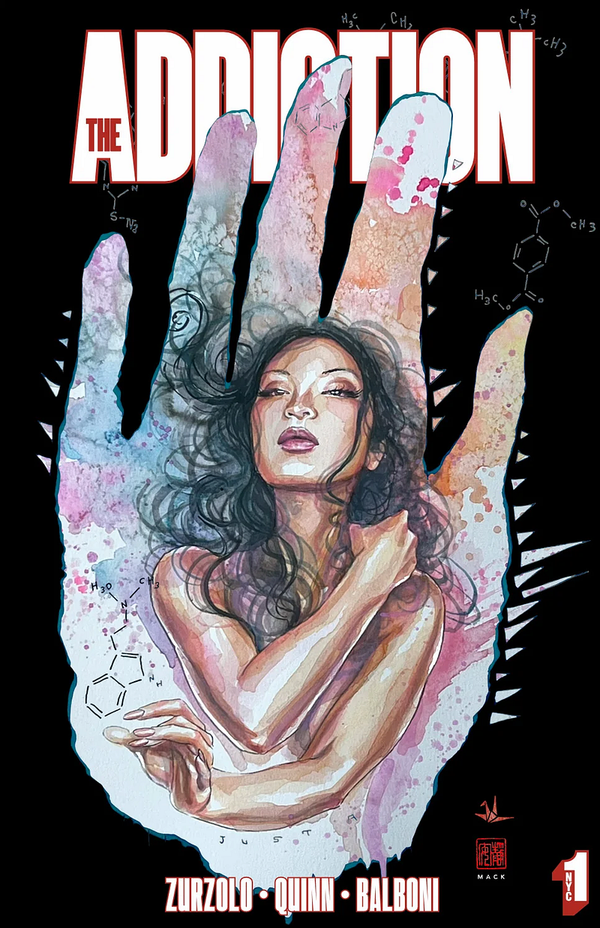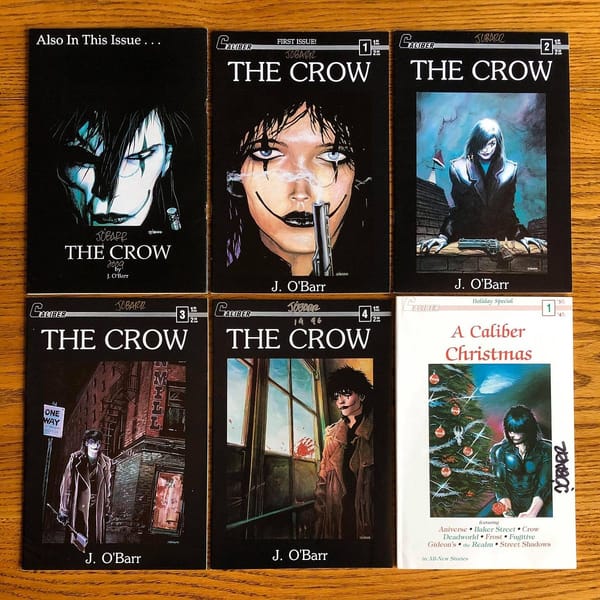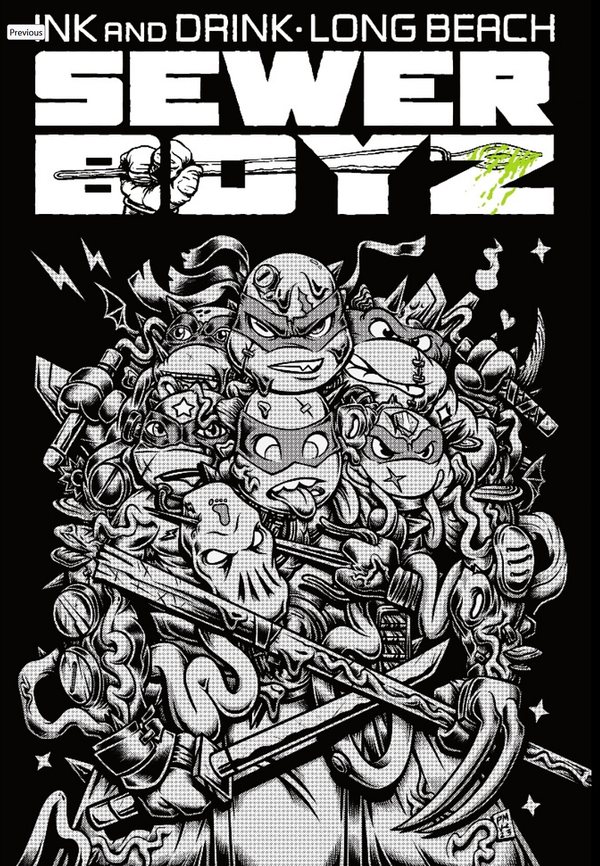Sewer Mutant Interviews Cry for Dawn Co-Creator Joe Monks
I just published an article on the rise and fall of Cry for Dawn, the influential Outlaw Comics/horror anthology from the late 80s/early…
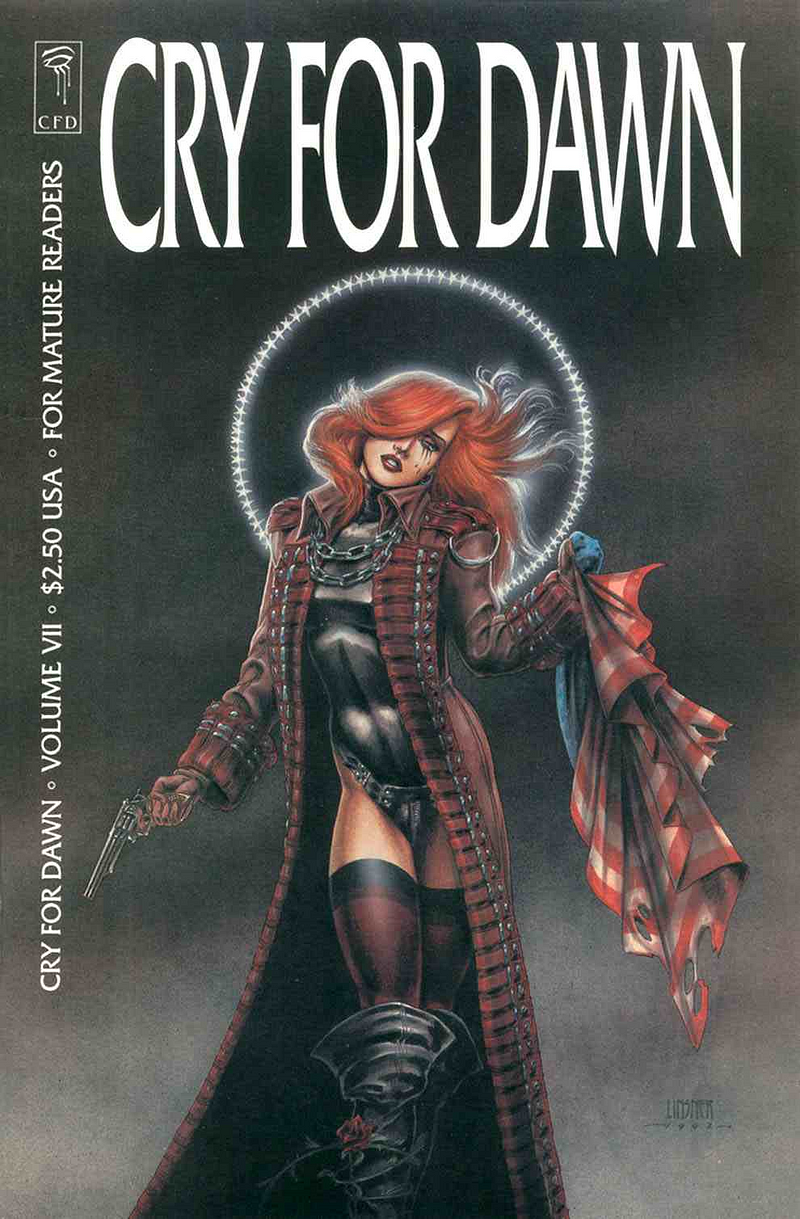
I just published an article on the rise and fall of Cry for Dawn, the influential Outlaw Comics/horror anthology from the late 80s/early 90s. Co-creators Joe Monks and Joe Linsner were kind enough to provide lengthy answers to my questions. There was far more material than I could use in the article, so I’m publishing their responses in full. Monks’s interview is below. Linsner’s interview is here. To keep up with the latest from Monks, visit his website.
How did you meet Joe Linsner? How did you guys decide to make a comic together?
We met in fifth grade and really became friends in seventh grade. We’d hang around, writing stories and putting illustrations with them. From the time I was nine and found an old, portable typewriter in the back of my Dad’s closet, I’ve been churning out stories. I think Joe was pretty much the same from the time he could wield a pencil, so in addition to sharing interests, we both had that kind of focus early on: stories and art. That was going to be our lives, so when a friend who worked in a comic shop told us we could print a couple thousand copies for $1,500? Bingo — we were in.
Linsner wrote in Cry for Dawn # 9 that you wrote your first novel at the age of 12, is that true?
Yes, my first novel was at 12, though edits took me into 13. For one of the early books, Joe actually did a cover. Needless to say, best if no one ever sees that “novel” or its cover. :)
Do you have any memories or anecdotes from the Cry for Dawn era you’d like to share?
One of the best was how I got introduced to “the spittle guy” — Bernie Wrightson. It’s our first con, November 1989. I came into comics knowing virtually nothing about them besides buying horror comics at used bookstores. But, I owned some of Bernie’s work, and I’d mentioned to Joe once that the spittle in a screaming character’s mouth was a fantastic detail. He said, “Oh, that’s Bernie Wrightson.” So, we’re setting up, and who do we find ourselves sitting next to? Bernie. Later, Bernie’s selling a fan something, and he’s scrambling around, looking for his signing pen. It was just him working his table, he’s checking his art stuff, seeing if it dropped on the floor, and I’m going, “Pssst! Bernie…Bernie… Bernie!” and he looks up, angry, and says, “What?!” and I’m holding out a brand new pen from a pack I’d brought. From that point on, we became great friends. I regret not working with him more, he’d’ve been incredible on a story in Sick and Twisted. We put in an homage page specifically for him that I hope he got a chuckle out of from upstairs.
What about the expansion? How did Lance Tooks, Ed Polgardy, Jim Balent, Kevin Taylor, etc. get involved?
In a word: cons. Frank Forte was living up in Connecticut and we met up with him at a show, and when I saw his work in “Dead Thing,” I told Joe, “We need this story.” Joe agreed, and that was the first story we decided to run that Joe didn’t draw. We met Kevin Taylor, an NYC local, and his samples floored us. For the most part, that’s how it worked. We got tipped to Jim Balent and Ed Polgardy by a buddy with a comic shop in Pennsylvania, Tom Barnes, just when they’d started releasing Blood Vows. Things were going okay, we weren’t dead broke, so we decided, “Hey, Kevin has a book that hasn’t been picked up. You wanna put it out, see how it goes?” Boom — Girl: Rule of Darkness. Once we released one book, lots of people started pitching. Didn’t always go well, but we really wanted those creators’ books to succeed, that’s why we took the risk on them.
Are you willing to talk about why you and Linsner split and the original Cry for Dawn ended?
Not something I’m jazzed about, but in short, we were going in different directions on our baby — a hardcore horror title. Somewhere, I have an 8mm video with David J. Schow introducing me at a Chiller Expo as “One of the godfathers of splatterpunk.” We’d had copies of Cry For Dawn banned in multiple countries. Printers who refused to print the book. Behind the scenes, there was a push to move more toward dark fantasy, and “pull back” on the really rough stuff. I think it’s noticeable in the covers for Cry 8 and 9. As well, we’d listed the Cry For Dawn Compilation book three times, but canceled, despite great orders. Obviously “compilation” means stuff we’d already released, but things kept needing touch-ups. Other “issues” kept coming up, and once you’d canceled a title three times? Orders went poof. Over thirty grand into the dumpster. That, plus the lead time between issues had grown to such an extent that we were losing fans. Anybody can look it up, see how many times we listed the compilation book. By ’93, lots of projects were getting canceled, and to me, that’s the crux of it. Were there other reasons? Sure, but man, the focus of the book that got promoters flying us around the country and tens of thousands of dollars that vanished because we couldn’t get out a book that was already sold out as individual issues? Tough to overcome. I think this is why Sick ‘n Twisted has fared so well. No drama, no one telling either of us, “Oh, you can’t put that into a story!”, etc. I have nothing against fantasy and dark fantasy, but Cry For Dawn was a horror title. That’s what made it, and by issue 8 that was getting lost.
The issues raised in Cry for Dawn seem more relevant now than ever, with the reversal of Roe v. Wade and comics facing a new wave of challenges, such as the obscenity suit in Virginia against Barnes and Noble, Oni/Lion Forge, and Gender Queer creator Maia Kobabe. Any thoughts on that?
I’ve been told by readers, to my face, “Oh, I know what you’re getting at here,” referring to “Kids Meal,” the abortion story from Cry For Dawn 1, and that’s been brought up a few times recently. Thing is, that story champions no “side,” has no “cause,” and it’s simply subject matter that was in the news at the time. We had no agenda — it was a good plot device. To have people come up and tell you you did something you had zero intention of doing? Kinda insulting. They think they know better than the guy who wrote it? Where’s your hit comic, chief?
Had Linsner not written “The concept that abortion might actually get outlawed again scares the hell out of me” in his editorial in Cry for Dawn # 1, I might have interpreted “Kids Meal” as an anti-abortion story. Is it safe to say that ambiguity was intentional on your part? Relatedly, would it be reasonable to say that Cry for Dawn was often more about pushing boundaries rather than delivering a particular message?
We both knew people who’d had abortions, and I’ve never been anti. Thing is, I understand that there’s the other “side” (which is huge, even more so back in the late ’80s) who oppose it. Like George Bernard Shaw said, “if you want to be successful, offend the greatest number of people.” We didn’t want to look preachy for sure, but I also didn’t want to alienate that big a percentage of our audience. We had no names, no reputation, and the book itself was going to turn off a lot of people, which it did. Tony Isabella hated it. The folks at CBG weren’t fans. There is no happy ending for *anyone* in Kids Meal, which I think makes it even more horrific. That was intentional.
It’s well-known that I would gladly make the tradeoff for significant global warming in a year if all pedophiles were to spontaneously combust. Even so, as early as Cry for Dawn # 3, with “Playmates,” there is no issue push. Writers who know how to make an impact try to affect every reader, not just give some who hate pedos a cheery ending where a bunch die. The tale always has to stand on its own and make people think. You can’t do that just pandering, and I was conscious of that with all but one story in the ‘Cry run.
Sadly, these [censorship] issues seem to have a cycle. When retail outlets went into panic mode over the PMRC and similar groups seizing content and serving owners with papers all to try and kill those creators’ markets? That was big Al Gore’s wife using government weight to censor artists she didn’t like, and we fought like hell. When it comes to creators like Maia Kobabe, I understand where the plaintiffs stand, because they couldn’t care less if it’s Kobabe or E.L. James. Me personally, as someone who has had books banned (not just the threat of it), I can sympathize on the Barnes & Noble front, but elsewhere? Less so. I don’t expect thirteen-year-olds to be getting Sick ‘n Twisted at their local comic shop. I’m cool with that. There’s a difference between a ban and having age restrictions. 50 Shades got into a couple of high schools somehow, and I think no matter how anti-censorship you are, there are lines. Back in the day, when newsstand porn was big, kids couldn’t buy Hustler at the local Stop & Go. When video stores were booming, same with the tapes in the back room. No one balked about keeping 6th graders from renting hardcore smut and explicit content. At least now, people are pushing parental involvement, which I see nothing wrong with. You don’t want Gender Queer being checked out by 12-year-olds without permission at school? Cool. You want your kid to have access? Get it out of the regular library or buy a copy. Everybody’s treated fairly, nothing is ‘banned’ despite the clickbait hysteria, and everyone’s views are respected. Those options weren’t as plentiful back in 1990 when the internet was little more than AOL, CompuServe and Usenet.
Much of the backlash against Gender Queer and other books has been about them being stocked in the adult section of public libraries. There’s been a huge backlash against librarians over the past couple of years. There’s no constitutional right to have your book included in a public library, but there’s a real push to try to keep this stuff out of even adults’ hands.
I agree, but it’s one of many cases and differing views, most not about bans, but about age-appropriate material. Some districts took To Kill a Mockingbird out of their school districts starting several years ago because of the dreaded ‘N-word’. Some Seattle schools did just this year. Maus got pulled from a TN school district, and the shame is, the media twisted that around into nothing remotely close to a ban. They dropped it (as they have with books for something like the past 12 years), that have material in them they consider age-inappropriate. I was one of the first people to interview Art when Maus came out, and he sent me a signed copy. Love him, but nothing was banned. The content parents pointed to (the nudity and profanity and violence ) are all in there. And, if anyone actually called the school or spoke to their spokesperson (I did and posted about it when that story broke), they would have listened to the minutes of that board meeting in which their attorneys handled it. The book wasn’t banned, merely taken out of middle school curriculum. Maus is great, but so is One Flew Over the Cuckoo’s Nest. It has a vicious, violent rape scene, brutal language, and murder. Because Kesey’s won awards and is a revered author should 12-year-olds get a hold of it? I’m okay if they have to wait ’til 16, and that includes books like Gender Queer, Dirty Plotte, Taboo, and mine. It looks to me like a lot of ‘outlets’ have reported on bannings that have never been, simply because it’s great clickbait.
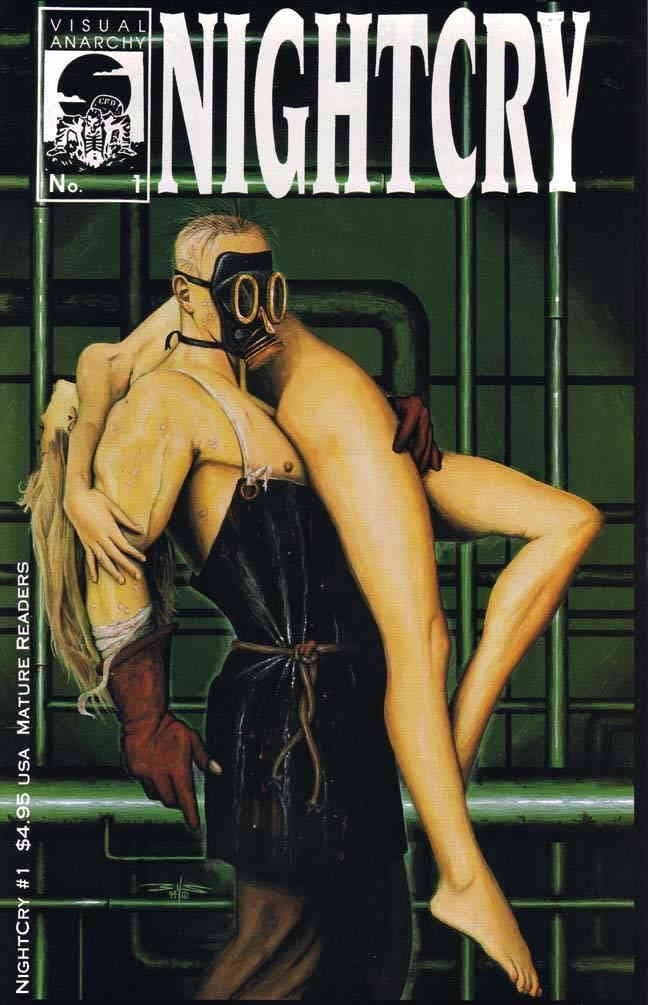
Why did Creative Forces Design & Production become Chanting Monks?
Simplicity. I had to come up with something immediately after the ‘Cry business split was final, where we could still use CFD to keep the same spot in the catalogs. So, workable, but too long. John Orlando gave me this sketch of a concept he’d been working on right about the time the B&W indie market hit bottom, and I decided keeping the initials didn’t matter anymore. Chanting Monks Studios was much shorter, and the monk logo fit. $75 and a stop at my attorney’s office, and it was official.
What are some of your favorite highlights from your post-CFD career?
Well, The Bunker is a biggie. I’d sold a treatment for a half-hour TV pilot, and I had a feature script that I thought would be easy to shoot. Not for me, but for a team of indie filmmakers. Y’know, people with sight! I had just enough internet skill to start researching, and contacted Variety, Hollywood Reporter — the biggies. I walk into my wife’s office and tell her: “I’m going to direct a film. Blind. It’s never been done before.” She sits there for a minute, and I think she’s about to tell me I’m nuts, but then she says: “Okay, How?”
My video opened the New York Latino Independent Film Festival a couple of years ago, and just being invited to submit something was mind-blowing. People say, “Oh, I’m honored…” all the time, and often it’s just bullshit. But, these folks had access to creators whose names turn heads. To get contacted by their board asking, “Hey Joe, you want to send something over?” Top five.
Right now, getting the first issue of Sick and Twisted out has been a wild ride, but I just did my first convention in over 10 years. Somebody who browsed the book came around the table to get close enough to tell me they’d pray for me. Getting people to believe they need to pray for you over your fiction? I dunno, I kinda think that’s the best review you can get!
How did Bernie Wrightson get involved with you and Chanting Monks?
Damn, kinda threw the SPOILER wrench into this one, eh? Well, Bernie was a guest at a Chiller Expo and we hung out. He started talking to Pam who did web stuff. End of the weekend, Pam’s repping Bernie and we’re going to run his fan club. The more we traveled to the same shows, the more we saw our projects making money — even if not “standard” comics fare. We did an e-book even before the term e-book existed. He loved the idea of having stories interwoven with an art portfolio, and I’d never seen one. I told Bernie: “Why not us?” So we ran with it. He was the kind of guy you could work with and never have a disagreement. Didn’t mean you were always on the same page, and sometimes we went back and forth on how to get something across, but disagreements? Never.
